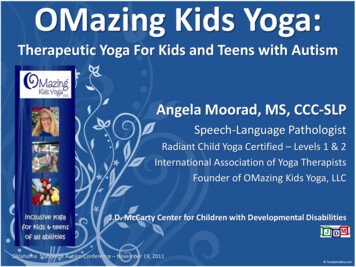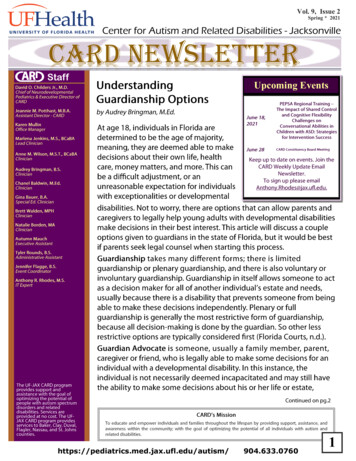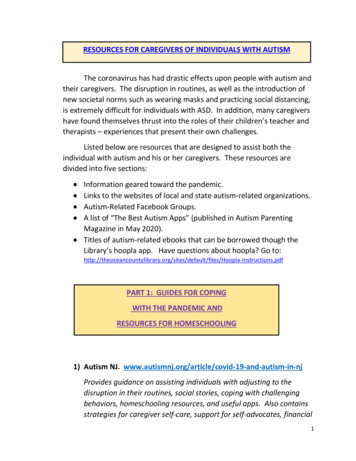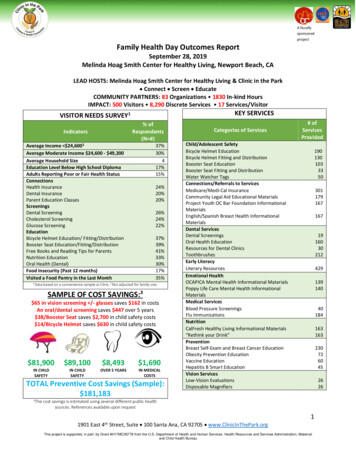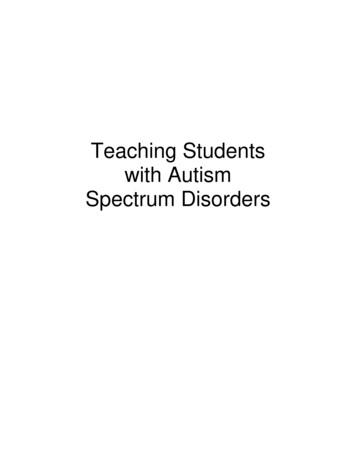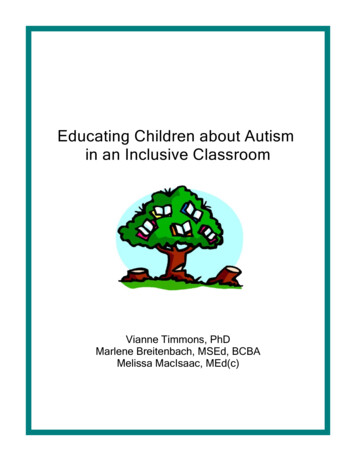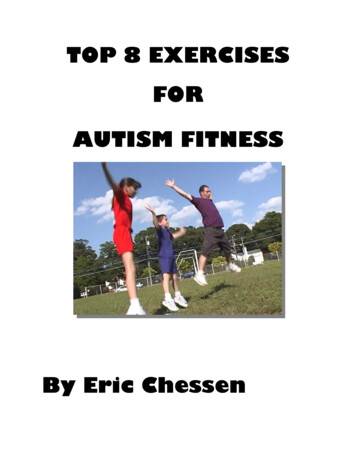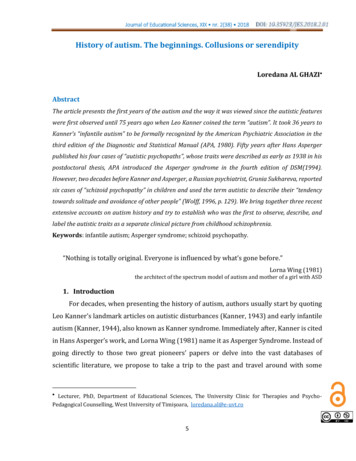
Transcription
Journal of Educational Sciences, XIX nr. 2(38) 2018History of autism. The beginnings. Collusions or serendipityLoredana AL GHAZI AbstractThe article presents the first years of the autism and the way it was viewed since the autistic featureswere first observed until 75 years ago when Leo Kanner coined the term “autism”. It took 36 years toKanner’s “infantile autism” to be formally recognized by the American Psychiatric Association in thethird edition of the Diagnostic and Statistical Manual (APA, 1980). Fifty years after Hans Aspergerpublished his four cases of “autistic psychopaths”, whose traits were described as early as 1938 in hispostdoctoral thesis, APA introduced the Asperger syndrome in the fourth edition of DSM(1994).However, two decades before Kanner and Asperger, a Russian psychiatrist, Grunia Sukhareva, reportedsix cases of “schizoid psychopathy” in children and used the term autistic to describe their “tendencytowards solitude and avoidance of other people” (Wolff, 1996, p. 129). We bring together three recentextensive accounts on autism history and try to establish who was the first to observe, describe, andlabel the autistic traits as a separate clinical picture from childhood schizophrenia.Keywords: infantile autism; Asperger syndrome; schizoid psychopathy.“Nothing is totally original. Everyone is influenced by what’s gone before.”Lorna Wing (1981)the architect of the spectrum model of autism and mother of a girl with ASD1. IntroductionFor decades, when presenting the history of autism, authors usually start by quotingLeo Kanner’s landmark articles on autistic disturbances (Kanner, 1943) and early infantileautism (Kanner, 1944), also known as Kanner syndrome. Immediately after, Kanner is citedin Hans Asperger’s work, and Lorna Wing (1981) name it as Asperger Syndrome. Instead ofgoing directly to those two great pioneers’ papers or delve into the vast databases ofscientific literature, we propose to take a trip to the past and travel around with some Lecturer, PhD, Department of Educational Sciences, The University Clinic for Therapies and PsychoPedagogical Counselling, West University of Timișoara, loredana.al@e-uvt.ro5
Journal of Educational Sciences, XIX nr. 2(38) 2018special guides, nor psychiatrists or psychologists. The first is Steve Silberman, an Americanscience journalist, who wrote the book Neurotribes:The Legacy of Autism and the Future ofNeurodiversity (Silberman, 2015). Our second guide is Adam Feinstein, a journalist,Hispanist and father of Johnny who is autistic (Introducing myself Adam Feinstein’s blog,”n.d.), author of A History of Autism: conversations with the pioneers (Feinstein, 2010). Thelasts are two American journalists, John Donvan, multiple Emmy Award-winning, andCaren Zucker, mother of Mickey, diagnosed with autism, authors of the book In a differentKey. The story of Autism (Donova&Zucker, 2016). Although not academic books, the authorssupport their writing with rigorous citations to sources and impressing extensivedocumentation (Odom, 2016).Each of the authors mentioned above was greatly acclaimed and received numerousprizes, but also their books reaped a whirlwind from some academics or part of the public.That is the reason why we were interested in having a scientific, hence impartial opinion onthose three accounts of autism history. While researching for our project on ASD (Luştrea,A; Al Ghazi, L.; Borca, C., 2017), these books were brought to our attention by Simon BaronCohen who wrote: “a stunning big book NeuroTribes, big in size and big in vision, spanningthe history of autism from the late 19th century to the present day” (Baron Cohen, 2015, p.1329), ”terrific book” (Baron Cohen, 2017, p. 746). About A History of Autism: conversationswith the pioneers, Baron-Cohen said is ”a treasure-trove” (“Praise for my new autism book Adam Feinstein’s blog,” n.d.). The book In a different Key. The story of Autism is “a bookwhichmakes a remarkable contribution to the history of autism”, in Baron-Cohen words (“ADefinitive History of Autism - The Crown Publishing Group,” n.d.). Baron-Cohen has his wellset place in the autism’s history as the author of the book Theory of mind ( ), and as a multiawarded scientist. He is also professor of developmental psychopathology at University ofCambridge, and director of Autism Research Centre. After 40 years spent in the field ofautism, if ”Simon says” about a book that it is ”one of the most fascinating accounts of autismI have ever read” and promise to ”uncovers the secret that one scientist tried to hide”(Baron-Cohen, 2015, p. 1329), then that book is a must-read for anyone interested inautism. Silberman is taking us back in the 40s and brings together both Kanner andAsperger in revealing “a well-kept secret about autism.”6
Journal of Educational Sciences, XIX nr. 2(38) 20182.The West Side Story. KannerThe scientist who supposedly had secrets to hide would be Leo Kanner himself, notonly the father of autism syndrom, but the father of child psychiatry in USA (Eisenberg’stribute to Kanner, cited by Feinstein, 2010)). Child psychiatrist at Johns Hopkins UniversitySchool of Medicine in Baltimore, in 1943, he reported in his groundbreaking article that”since 1938 there have come to our attention some children whose condition differs somarkedly and uniquely from anything reported so far” (Kanner, 1943, p. 217). Kannerdescribed eleven cases of his child patients: they appeared isolated from the world,withdrawn from social contact, and most of them had severe intellectual difficulties(Kanner, 1943). He labeled these observed features as autistic. Actually, Kanner borrowedfrom Eugene Bleuler the term autism (from the Greek term autos self), which means,literally, being absorbed in oneself, a morbid self-absorption (Evans, 2013) and credited theSwiss psychiatrist with introducing the term in psychiatry. Kanner repeatedly claimed thatit was for the first time, in 1943, that such cases were described in the literature, so he wasthe first to name those features as autistic.Silberman believes things are quite different and he also thinks he can prove it. AsBaron-Cohen put it, “In science, as in commerce, or exploring space, being there first isimportant, and Silberman sees the real importance of what he has stumbled upon” (BaronCohen, 2015, p. 1329). What Silberman stumbled upon was the Hans Asperger’s work andother authors publications that clearly shows Kanner descriptions of autistic traits were notthe first ever reported, nor Kanner is the first to use the term autistic. However, Silbermanwas not the first to suggest that Kanner borrowed more than the term autism for hissyndrome, but also the ideas of other psychiatrists. Adam Feinstein (2010) pointed on thesame issues in his book, as well as Fitzgerald in the chapter ”Autism: Asperger’sSyndrome— History and First Descriptions”(Fitzgerald, 2008; Lyons & Fitzgerald, 2007).Silberman however made a step forward by mentioning in premiere the link betweenKanner and the Viennese scientists Georg Frankl.Silberman made his case based on to the fact that before Frankl’s arrival in the US, inKanner’s clinic, there is no evidence that Kanner had any interest in what we now callautistic behaviors (Robison, 2017). Frankl was the principal diagnostician in Asperger’s7
Journal of Educational Sciences, XIX nr. 2(38) 2018Clinic in Vienna, where he worked for eleven years, five close to Asperger. As other jewcolleagues before him and as well as his future wife, Anni Weiss, he ran from Nazi terrorand left Vienna for the US. Silberman implies that through Frankl and his wife, Kanner sawthe opportunity to make history in medicine describing a new condition, namely the autism,and never credited Asperger in his demarche. It is also Silberman’s assumption that theFrankls remained silent feeling greatly in debt for Kanner facilitated their new life in the US.According to Kanner, his article presents “characteristics form of an unique syndrome, notheretofore reported” (Kanner, 1943, p. 242). Nevertheless, Frankl would have known thatthis was not the case, since he himself and his wife had presented similar descriptions asearly as 1933-1935 (Donvan, Zucker, 2016; Robison, 2017; Silberman, 2015).Anni Weiss-Frankl published in American Journal of Orthopsychiatry (Weiss, 1935)the case of Gottfried, a boy she consulted while she was working at the University Children’sClinic in Vienna. She left Vienna in 1934 and her future husband, Georg Frankl, in 1937. So,on 3 October 1938, when Asperger presented his thesis (Feinstein, 2010), in which he calledhis patients Autistischen Psychopathen, autistic psychopaths1 (Donvan & Zucker, 2016), theFrankls were not in the auditorium. They were no longer in Europe, but in Kanner’s innercircle at Johns Hopkins (Silberman, 2015). Silberman advanced the idea that if not fromAnni Weiss, then Frankl surely must have heard the word autistic right from Asperger's lips,as a label for the children he consulted in his Clinic. Feinstein (2010, p. 11) citing Asperger’sdaughter, Maria Asperger Felder (2008), evokes a letter dated April 14, 1934, in whichAsperger “discusses the difficulties of diagnostic concepts and suggests the possibility thatautistic might be a useful term”.How close Frankl and Kanner's relation was, how much the two men talked about theircases, if Frankl really informed Kanner with details about his work with Asperger and howAsperger denominated the traits he observed in children, we do not know. Kanner onlynamed Frankl as one of many clinicians whom he helped immigrate to America and credithim for conducting his observations and evaluations of two of his eleven cases, but nevermentioned him in his work again (Silberman, 2015, citing Kanner’s Unpublished memoirs).To note that in German, “psychopathy” has not the connotations of a profound mental illness as in English.18
Journal of Educational Sciences, XIX nr. 2(38) 2018However, if the two men have had talked about Asperger’s work and vision, we canspeculate it was not in 1938, but later. We say so because on 7 October 1938, four days afterAsperger defended his thesis on autistic psychopaths in Vienna, Leo Kanner met five yearsold Donald Triplett for the first time in Baltimore.After reading the detailed letter sent by Donald’s father and meeting with the child,the most renowned child psychiatrist in the US was not able to provide a diagnostic to theparents. Instead, he sent little Donald to Frankl for further evaluation. After two weeks oftests and observations, Frankl notes “? Schizophrenia”(Silberman, 2015). Although themother insisted for a diagnostic, Kanner had no label to give. ”Donald was different fromany other child he had treated and unlike any description in any textbook” (Donvan &Zucker, 2016, p. 36). A year later, the diagnostic was still unclear. Kanner and Donald’smother wrote each other at least twice a month for the next four years. In 1942, the motherwrote again, reproaching that Kanner gave her only “generalities” whereas she needed“specifics” (Donvan & Zucker, 2016). “Nobody realizes more than I do myself that at no timehave you or your husband been given a clear-cut and unequivocal ( ) diagnosticterm”(Autism’s First Child - The Atlantic, 2010). Finally, the name autistic for thedisturbances Donald displayed is announced in a letter to Donald’s mother on September28, 1942, and became part of the title of his 1943 article (Donvan & Zucker, 2016). A yearlater, Kanner comes with the name for the syndrome- early infantile autism (Kanner, 1944).However, the Frankls were not in Kanner’s circle anymore. They left Baltimore at the end of1940 (Silberman, 2015). So Kanner was on his own when he formulated his conception ofthe syndrome, between 1942 and 1944. How much the two-man talked about Franklexperience shared with Asperger, as a principal diagnostician in the Viennese Clinic,remains unknown.Silberman produced however more circumstantial evidence than the others whoaccused, indirectly or directly, Kanner of plagiarism of ideas, by identifying Frankl as theconnection between Kanner and Asperger. However, in Kanner’s defense, we may say thathis first case, the notorious Donald T., was referred to him in 1938 by the child’s pediatricianand Donald fathers’ letter stands for it. It is true that Frankl was involved in Donald’s case(as well as in another one, Elaine’s, who came an year later, in 1939), but it is also proved9
Journal of Educational Sciences, XIX nr. 2(38) 2018that in 1942 Kanner was still unsure how to label Donald’s condition (see Kanner letter toDonald’s mother). In a three year window (1938-1940), Frankl probably had manyopportunities to talk to Kanner about the resemblances between his cases and Aspergers’.If Frankl did suggest the term autistic, taken from Asperger, why was Kanner hesitant inusing it and waited until 1942 if he was eager to come first? If Kanner included aspects ofAsperger’s thinking into his own model of autism, without crediting him, still cannot beruled out as a possibility.If we admit that Kanner was not aware of Asperger work and that they applied theidentical word to the independently observed behaviors, we can not agree with Kanner’sclaim that he was the first to describe those peculiar behaviors in children. Feinstein, citingGilberg, inform us that Kanner was ‘‘so very well aware of people writing in other languagesat the same time that Asperger was working’’ (Feinstein2010, p. 11). Even if he was notaware of Asperger’s 1938 thesis, undoubtedly he was in current with the first account of“childhood schizophrenia” in America, published in 1933 by Howard Potter and also withLouise Despert several case histories reported in 1938 or in 1942 in a paper published inthe same journal, Nervous child, in which Kanner published his seminal article in 1943(Feinstein, 2010). Despert’s reaction to the claims that the condition Kanner wrote aboutwas “heretofore unreported” and “unique” was kind of ”Had he not been reading mypapers?“. Silberman is quoting Despert commenting Kanner: ”It seems to me that thegreatest contribution this article is making is in its thorough, accurate, and illuminatingdescription of clinical cases,” she wrote. “However, if you will permit me to say so, I objectto the coining of new terminology for entities which, if not so carefully described, have beenpreviously reported” (Silberman, 2015, p 124). She herself even referred to her cases withautism, but in Bleuler’s sense of the term, as a clinical sign of schizophrenia. However,Kanner never considered autism as an early form or prodromal phase of schizophrenia, asDespert did, but as a condition sui generis.10
Journal of Educational Sciences, XIX nr. 2(38) 20183.The East Side Story. Asperger and SukharevaAlmost two decades before Kanner (1943) and Asperger (1944), Grunia Sukharevadescribed what we now call autistic traits in her original article, first published in Russian,in 1925, and next year, in German, under the title Die schizoiden Psychopathien imKindesalter. For 2-years, she observed the children at Psychoneurological Department forChildren in Moscow and then published six case reports of what she had called schizoidpsychopathy in children, according to Bleuler and Kretschmer classification. Wolff translatedin English Sukhareva’ s German version of the article (Wolff, 1996) and implies thatAsperger must have been aware of Sukhareva’s “structured, elegant and detaileddescriptions” (Manouilenko & Bejerot, 2015, p. 2). Wolf then raised the question: ”How wasit that Asperger did not apparently know of this paper?” (Wolff, 1996, p. 120).How much Asperger actually knew of Sukhareva’s observations and her dilemma onthe ”disorder whose clinical picture shares certain features with schizophrenia, but whichyet differs profoundly from schizophrenia” (Wolff, 1996, p. 131) it is hard to tell.Supposedly, at the University Clinic in Vienna, Frankl, Weiss or Asperger did not know aboutSukhareva article, since none of them is citing her, although at the time there were not toomany journals printed in German in the field of psychiatry. These journals were the firstsource of information for academics as well as for practitioners,so it is hard to believe thatAsperger, who cited an article on child psychiatry published in the same journal, in 1938,never came across with his Russian colleague’s paper. Sukhareva and Asperger both citedBleuler and Kretschmer ’ s early work on schizoid personality in adults (Manouilenko &Bejerot, 2015). However, none used the term autistic in relation to the cases described untilAsperger gave the first public lectures on autism as early as 1938.Asperger called his boys Autistischen Psychopathen. In German, the word psychopathywas akin ”to the term personality disorder with none of the connotations of the derangedor criminal mind that it bore in English” (Donvan & Zucker, 2016, p. 238). Aspergerconsciously has designated the word autistic to describe the inward, self-absorbed aspectthat was reminiscent of schizophrenic withdrawal, but also unlike it. Schizophrenia is notpresent in young children, as early as the age of two and the children did not experiencehallucinations or hear voices, as was typical of schizophrenia. The lack of social contact is11
Journal of Educational Sciences, XIX nr. 2(38) 2018present in schizophrenia and autism, like the fever is present in many conditions: as asymptom.Asperger published The ‘Autistic Psychopaths’ in Childhood (in German, Die‘Autistischen Psychopathen’ im Kindesalter) in Archiv fur Psychiatrie und Nervenkrankheiten,in 1944, an year after Kanner published Autistic disturbances of affective contact, in NervousChild (Robison, 2017). Neither Asperger nor Kanner cited Suhkareva. The non-Germanspeaking researchers remained unfamiliar with the work of Asperger until 1981, whenWing presented the features of what she named Asperger Syndrome, and Uta Frithtranslated Asperger s article, 47 years after his publication in German (Asperger, 1991).4.Rewriting the history of autismAfter bringing together Feinstein, Silberman and Donvan&Zucker accounts an earlyhistory of autism, we concluded that Kanner’s syndrome and “Kanner- father of autism” aremyths demolished, in part, by the above mentioned. We limited ourselves to mention justthe published articles of other authors prior to 1943-1944, to show that Kanner, in his ownwords “never discovered autism; it was always there” (Silberman, 2015, p. 188). Hundredyears before 1943, there were records of what we now call autistic features and autisticpeople (see Donvan and Silberman’s descriptions of Basil, the holy fool from Russia, HughBlair, Itard’s wild boy of Aveyron, Howe’s Case 27-Billy). If we can ignore those livresqueaccounts, we can not overlook the Suchareva, Weiss, Asperger and Despert reports, all thearticles-published before 1943.5.ConclusionsWhat we know:1.Asperger was the first to use the word autistic to describe the unusualbehaviors observed in children. He borrowed the term from the Bleuler’s schizophreniasymptom list. In Bleuler’s schizophrenic adult patients, the cutoff communication and thepreference for isolation appeared to come and go, while Asperger observed that children donot withdraw and isolate, merely they ”were never in”. Although ”extreme emotionalisolation” from other people, which is ”the foremost characteristic of early infantile autism”,12
Journal of Educational Sciences, XIX nr. 2(38) 2018bears so close a resemblance to schizophrenic withdrawal (Feinstein, citing Kanner, p. 27),both Asperger and Kanner designated the term autistic being aware of these differences andexplaining it repeatedly.2.Sukhareva pointed out, two decades before Asperger, the distinction betweenthe early-onset of the features observed in her children patients and the schizophrenic signsthat appear later in adolescence and in young adults. In the last case, the patients almostinvariably decline and disintegrate, while the children’s condition often improves in time.Her merit is to accurately describe the traits such as the lack of interest and the lack ofengagement in social contact, along with restricted and repetitive behaviors, and astutelyobserved that these differ from schizophrenia. Asperger concluded the same, but he camewith the name autistic psychopathy instead of schizoid psychopathy for what later waslabeled as Asperger syndrome.3.Kanner was not the first to describe autistic traits, but he was the first topublish an article in which appeared both the differential diagnosis of the features heobserved from childhood schizophrenia (as in Sukhareva and Asperger) and the label forthem, autistic disturbances. He was the first to show that this complex set of behaviorsconstituted a single, never-before-recognized diagnosis: autism.4.For years, Kanner maintained that his syndrome was monolithic by definition,limited to childhood. He also insisted that the autistic traits were innate, a hasty assumptionsince he never observed babies. Asperger, on the other hand, built his concept of autism asa broad and inclusive spectrum, a “continuum”, as his diagnostician, Georg Frankl, called itin an unpublished draft from the ‘50s, cited by Silberman(2015). Wing, the architect ofmodern autism model as a spectrum, also noticed that.Asperger and Kanner, although both labeled their cases autistic, they were focusingon different populations of children, and the conditions they described diverged in severalimportant respects. The authors themselves insisted on the differences between them, untilthe very end: “Asperger, despite listing numerous similarities, considered his syndrome tobe different from Kanner’s” (Donvan & Zucker, 2016, p. 241, citing Wing, 1981). Also,Kanner considered that Asperger ”independently described what he called autisticpsychopathy, which, if at all related to infantile autism, is at best a 42nd cousin” (Silberman,13
Journal of Educational Sciences, XIX nr. 2(38) 20182015, p. 140, citing Kanner,1970). The spectrum model of autism set by APA in the 1980srepresented a decisive defeat for the father of the this diagnosis and we will develop thesuject in another paper.What was implied but never proved:Kanner appropriated the work of others.In our opinion, there is no irrefutable evidence that Kanner was aware of Asperger’sor Sukhareva’s cases or that he appropriated or at least replicated their work in his Clinic,in Baltimore. We believe that Kanner could take the word autistic from Bleuler, as well ashe could take it, via Frankl, from Asperger. Maybe he considered that in the worldwidepsychiatric community the paternity of the term is so well-known, that in his first article hedid not even mention Bleuler. He mentioned Bleuler years after, for introducing the wordin psychiatry.Kanner may have been unaware of Suckareva’s and Asperger’s preoccupation inchildren displaying what we now call autistic features, in an epoch in which access toEuropean journals (or lectures) was not solely at a click distance. German-language paperswere not very popular in the US, in the war-time, and remained unpopular many years later,as well as the German authors (if they were not jews or suspicions of Nazi collaborationplaned upon them) as in Asperger’s case (Donvan & Zucker, 2016; Feinstein, 2010;Silberman, 2015). Although, Kanner may have been interested in German publications sincehe was a native speaker and the language barrier did not exist in his case. More than this,he was aware that psychiatry and psychopathology were born in Europe and the Americanshave a lot to learn especially from German written literature in the field. It is our guess thatif Kanner read German language psychiatry journals, it happened in US. At the time he wasin Europe, he was not a psychiatrist so it is less probable that he was interested in the field(that is reading Suckareva’s article).Silberman’s hypothesis that Frankl informed Kanner on his work with Asperger andKanner took Asperger ideas and integrated into his own model of autism is not ungrounded,but was never fully proved. The same stands true for the allegations that Asperger knewabout Sukhareva’s cases in Moscow and all he did was to replicate her work in Vienna andstick the label autistic on it.14
Journal of Educational Sciences, XIX nr. 2(38) 2018Some questions still remain, but, without strong evidence, these are merelyspeculations. Our suspicions do not refer to the 40s, but to the 1970s events: why Kannernever cited Asperger? Even after that night in July 1969, when he stated that ”I neverdiscovered autism. It was there before”, he maintained the view that somehow Asperger’swork was unworthy of serious consideration. Why did Asperger not say more on Kanner’swork? Why they never met, why they never wrote to each other? Was the scientist’s pride,was it that “jewish-german thing”? The only person in the world to answer those questionscould have been Georg Frankl. But he decided to remain silent. Like Gottfried in Annie’s1935 article, Frankl’s case, Karl, was not described as autistic, although he met all thecriteria to be portrayed in this way, due to his “lack of contact with persons in its mostextreme form” (Silberman citing Frankl, 1943). Frankl knew from Asperger that autisticterm would be best suited to describe Karl K. He preferred not to. Why? Maybe because hisarticle appeared in the same year and in the same journal in which Kanner published. And,by doing that, he would somehow contradict his former boss and benefactor’s theory?Silberman (2015) was talking about Kanner’s sin of omission. Echoing Silberman, wewould rather point on Frankl’s sin of omission and conclude with Silberman’s words: “Andthe one clinician in America who knew the real story was not apt to say anything about it inpublic, because he owed Kanner the ultimate debt: his life” (Silberman, 2015).Acknowledgments:The author expresses sincere gratitude to Anca Luștrea, a dearest colleague, for herkind comments that significantly improved the manuscript, for her unconditional day-andnight support and her constant encouragements.References:American Psychiatric Association (APA). (1980).Diagnostic and Statistical Manual of MentalDisorders, 3rd ed. Washington, DC:American Psychiatric Publishing.American Psychiatric Association (APA). (1994). Diagnostic and Statistical Manual of MentalDisorders (4th ed.). Washington, DC: American Psychiatric Publishing.A Definitive History of Autism - The Crown Publishing Group. (n.d.). Retrieved December 14, 2018,from .XBNshmgzZPYAsperger, H. (1991). ‘Autistic psychopathy’ in childhood. In U. Frith (Ed.), Autism and Asperger15
Journal of Educational Sciences, XIX nr. 2(38) .002autism Origin and meaning of autism by Online Etymology Dictionary. (n.d.). Retrieved December8, 2018, from https://www.etymonline.com/word/autismBaron-Cohen, S. (2015). Leo Kanner, Hans Asperger, and the discovery of autism. The -2Baron-Cohen, S. (2017). Editorial Perspective: Neurodiversity - a revolutionary concept for autismand psychiatry. Journal of Child Psychology and Psychiatry, 58(6), , J.; Zucker, C. (2010). Autism’s First Child. The Atlantic. Retrieved 010/10/autisms-first-child/308227/Donvan, J.; Zucker, C. (2016). In a different key : the story of autism. New York: Crown Publishers.Evans, B. (2013). How autism became autism: The radical transformation of a central concept ofchild development in Britain. History of the Human Sciences, 26(3), nstein, A. (2010). A History of Autism: Conversations with the Pioneers (1 edition). WileyBlackwell. https://doi.org/10.1002/9781444325461Fitzgerald, M. (2008). Asperger’s disorder. In J. L. Rausch, M. E. Johnson, & M. F. Casanova (Eds.),Asperger’s disorder (p. 369). Informa -qaIntroducing myself Adam Feinstein’s blog. (n.d.). Retrieved December 12, 2018, er, L. (1943). Autistic disturbances of affective contact. Nervous Child, 2, 217–250. Retrievedfrom http://www.neurodiversity.com/library kanner 1943.pdfKanner, L. (1944). Early infantile autism. The Journal of Pediatrics, 25(3), 156-1Luştrea, A., Al Ghazi, L., & Borca, C. (2017). Innovative Academic Course on Integrative Interventionsfor Children with Autism Spectrum Disorders. Journal of Educational Sciences, 2(36), 56–68.Retrieved from d/Lyons, V., & Fitzgerald, M. (2007). Asperger (1906-1980) and Kanner (1894-1981), the two pioneersof autism [2]. Journal of Autism and Developmental Disorders. o, I., & Bejerot, S. (2015). Sukhareva—Prior to Asperger and Kanner. Nordic Journal ofPsychiatry, 69(6), 1005022Odom, S. L. (2016). Steve Silberman: NeuroTribes: The Legacy of Autism and the Future ofNeurodiversity. Journal of Autism and Developmental Disorders, 46(5), 6-4Praise for my new autism book Adam Feinstein’s blog. (n.d.). Retrieved December 10, 2018, /praise-for-my-new-autism-book/Robison, J. E. (2017). Kanner, Asperger, and Frankl: A third man at the genesis of the autism16
Journal of Educational Sciences, XIX nr. 2(38) 2018diagnosis. Autism, 21(7), 862–871. https://doi.org/10.1177/1362361316654283Silberman, S. (2015). Neurotribes : t
Adam Feinstein's blog," n.d.). The book In a different Key. The story of Autism is "a book whichmakes a remarkable contribution to the history of autism", in Baron-Cohen words ("A Definitive History of Autism - The Crown Publishing Group," n.d.). Baron-Cohen has his well-set place in the autism's history as the author of the book .


